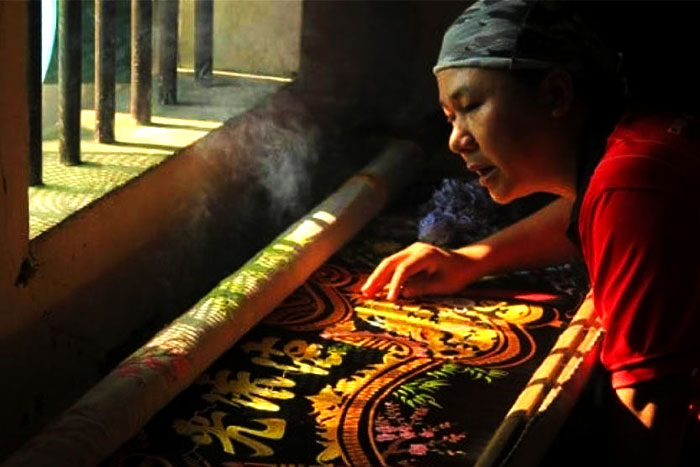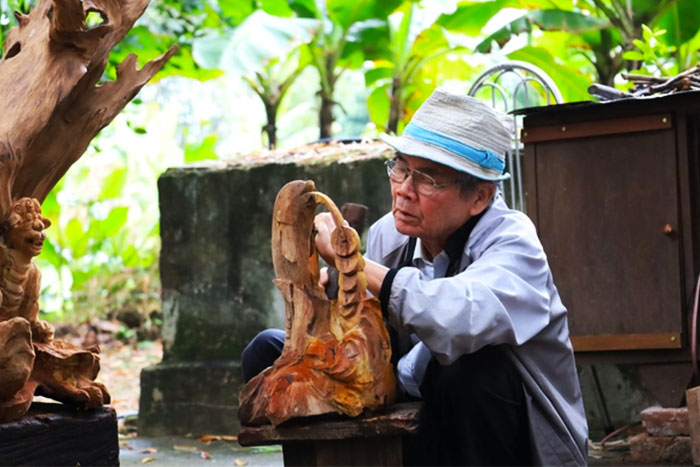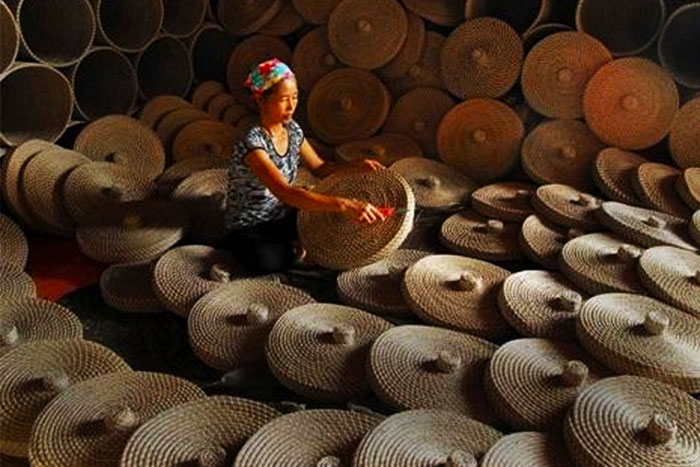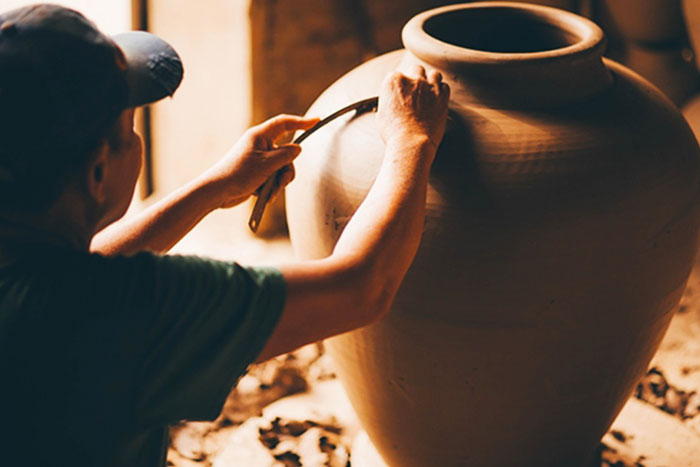Things To Do And See In Ninh Binh, Vietnam - Visit Traditional Handicraft Villages

Ninh Binh is an enticing destination with renowned landmarks such as Trang An, the Thung Nham eco-tourism area, Tam Coc-Bich Dong, and more. Additionally, Ninh Binh boasts numerous traditional craft villages with rich historical value. Despite the modern advancements in daily life, Ninh Binh maintains its ethnic identity and continues to captivate visitors with its historical charm, with many things to see in traditional handicraft villages here.
Table of Contents
1. Van Lam Lace Embroidery Village

Situated in Ninh Hai Commune, Hoa Lu District, this village is an integral part of the Tam Coc – Bich Dong tourism site, so it’s recommended for you to pay a visit here during your trip in case you don’t know yet what to do in Ninh Binh Vietnam. Legend has it that the first trace of embroidery craft here dates back to the Tran Dynasty over 800 years ago and was taught by Mrs. Tran Thi Dung, the wife of Tran Thu Do, a prominent politician who played a crucial role in establishing the Tran dynasty in Vietnam. Until the early 20th century, two brothers from the village, Dinh Ngoc Henh and Dinh Ngoc Xoan, ventured to Hanoi to learn the art of lace and embroidery from the French. Upon returning, they imparted their newfound knowledge to the villagers, sparking the gradual development of the lace and embroidery craft in the village.
Since then, the artisans have crafted a myriad of embroidery products, including clothing, bed linens, curtains, pillows, tablecloths, paintings, and more. The exquisite embroidery creations from Van Lam are showcased at fairs and tourist destinations nationwide, consistently attracting attention and admiration from both domestic and international patrons, hailing from countries such as Japan, Korea, France, Germany, Italy, the UK, and the USA. Skilled artisans use thin threads and colorful fabrics to create vibrant and intricate artworks. The delicate lace embroidery adds a touch of elegance to the local craftsmanship.
2. Ninh Van Stone Carving Village

Ninh Van Stone Carving Village, situated in Xuan Vu Village, Ninh Van Commune, Hoa Lu District, boasts a rich history spanning 400 years, making it a renowned craft village in Ninh Binh Vietnam. Historically, skilled artisans from this village were celebrated for creating stone statues destined for the ancient capitals of the Dinh and Anterior Le Dynasty, as well as for crafting ornate pieces for temples and pagodas in Hoa Lu. With masterful precision, these artisans transform rugged stones into exquisite works of art, producing statues, birds, and various decorative items adorned with intricate patterns that showcase their creativity and expertise.
3. Phuc Loc Carpenter Village

Located in Ninh Phong Ward, Ninh Binh City, Phuc Loc Carpenter Village has gained renown for its skilled craftsmanship in producing household and handicraft wooden items. With a heritage spanning centuries, the village has diligently preserved and transmitted its traditions across generations. In bygone times, Phuc Loc carpenters were celebrated for creating intricately sculpted wooden products used in the construction of churches, temples, and community houses. Presently, the village is home to over 600 households, encompassing a population of over 3,000 individuals, including approximately 400 skilled carpenters. Phuc Loc Carpenter Village serves as a living testament to the safeguarding of traditional carpentry techniques, drawing visitors from the province and beyond who are eager to experience the essence of this time-honored craft. Not only the popular tourist sites in Ninh Binh, but you can also visit traditional handicraft villages here to learn more about the culture of Vietnam.
4. Kim Son Sedge Mat Village

Among the many things to see in traditional handicraft villages, it's advisable to take a look at the enormous array of products made from sedge mat in Kim Son village. Located near Phat Diem Cathedral in Kim Son District, this village boasts a two-century tradition of cultivating sedge. Over the years, Kim Son people have transformed the landscape to cultivate sedge, creating a stable source for products like mats, baskets, trays, cups, hats, bags, and more. The sedge mat products are renowned for their stability and beautiful patterns, offering visitors a glimpse into the artistry of local craftsmen. Presently, sedge products from Kim Son have reached more than 20 countries.
5. Bo Bat Pottery Village

Formerly recognized as Bo Bat Pottery Village and now identified as Bach Lien Village in Yen Thanh Commune, Yen Mo District, this ancient pottery village boasts a rich history spanning thousands of years among many traditional handicraft villages in Ninh Binh. Its origins trace back over a millennium to the time when King Ly Thai To relocated the capital to Dai La citadel. During this period, he brought five major families from Bo Bat to the new capital to engage in the production of ceramic products. Renowned as the precursor to present-day Bat Trang pottery, Bo Bat Pottery Village has gained acclaim for crafting pottery items tailored for daily use and construction. The refined pottery pieces, which include cups, bowls, plates, and intricate artistic statues adorned with elaborate brocade patterns and vibrant colored enamel, stand as a testament to the enduring artistic legacy of the village.
6. Gia Thuy Pottery Village

Nestled in Gia Thuy Commune, Nho Quan District, this traditional pottery village has flourished for over 50 years. What sets Gia Thuy Pottery apart is its use of golden-brown ceramic, a material unique to the local area. This ceramic exhibits exceptional adhesion, smoothness, and resistance to high temperatures. Among the beloved products are wine bottles and jars, adorned with intricate patterns and scenes depicting Vietnamese villages, creating a distinctive hallmark of Gia Thuy Pottery.
> Top 05 Best Ways To Travel From Hanoi To Ninh Binh
> Things To Do At Thung Nham Bird Garden
> Best homestay in Ninh Binh
> Ninh Binh Travel Guide
> Ninh Binh Tours Package
> North Vietnam Tours
Related travel guide
Other similar articles
CUSTOMIZABLE BY LOCAL EXPERTS
Personalized trip at the original price!
REFUND GUARANTEE
We believe in our work and promise to give you money back.
GOOD PRICE / QUALITY
95% satisfied more than expected!
24/7 LOCAL SUPPORT
We are always available online to provide assistance at any time.
Most read articles
Autour Asia is highly recommended on
Embracing the mission of "Satisfied more than expected" and providing authentic experiences, we have received numerous recommendations on reputable travel forums:























